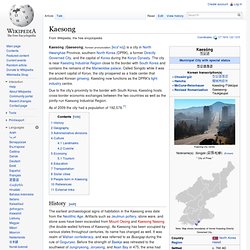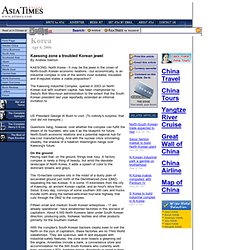

What's It Like to Be a Tourist in North Korea? - Interview by Christina Larson. On special guided trips, arranged for tourists and permitted by Pyongyang, Patrick Chovanec, a professor at Tsinghua University's School of Economics and Management in Beijing, has twice visited North Korea.

On each trip, he and his fellow travelers were accompanied by official guides, only permitted in certain areas, and asked to delete "objectionable" photos from their digital cameras. Yet the visits afforded Chovanec a rare glimpse inside the Hermit Kingdom. FP recently caught up with Chovanec to share his experiences to take us, vicariously, inside Kim Il Sung's mausoleum, a North Korean classroom, and a gilded casino that has seen better days. What we learned: North Korea is indeed a real place, where ordinary people must make due in extraordinary circumstances.
Foreign Policy: When were you in North Korea -- and where did you visit? Patrick Chovanec: I've made two trips to North Korea. I just returned from my second trip in July. FP: What were your impressions of Pyongyang? Kim Il-sung. Kim Il-sung (pronounced [kim ilsʰʌŋ]; born Kim Sŏng-ju; 15 April 1912 – 8 July 1994) was the leader of the Democratic People's Republic of Korea, commonly referred to as North Korea, from its establishment in 1948 until his death in 1994.[1] He held the posts of Prime Minister from 1948 to 1972 and President from 1972 to his death.

He was also the leader of the Workers' Party of Korea from 1949 to 1994 (titled as chairman from 1949 to 1966 and as general secretary after 1966). He invaded South Korea in 1950, and almost succeeded in overrunning the entire peninsula if not for UN intervention. The Korean War, sometimes referred to as the Korean Civil War, was stopped with a cease-fire signed on 27 July 1953. As of now, the Korean War has technically not ended.
His tenure as leader of North Korea has often been described as autocratic, and he established an all-pervasive cult of personality. Early life[edit] Communist and guerrilla activities[edit] Return to Korea[edit] Kim Il-sung in 1946. IMG_1722. Kaesong. Kaesŏng (Gaeseong; Korean pronunciation: [kɛsʰʌŋ]) is a city in North Hwanghae Province, southern North Korea (DPRK), a former Directly Governed City, and the capital of Korea during the Koryo Dynasty.

The city is near Kaesŏng Industrial Region close to the border with South Korea and contains the remains of the Manwoldae palace. Called Songdo while it was the ancient capital of Koryo, the city prospered as a trade center that produced Korean ginseng. Kaesŏng now functions as the DPRK's light industry centre. Due to the city's proximity to the border with South Korea, Kaesŏng hosts cross-border economic exchanges between the two countries as well as the jointly-run Kaesong Industrial Region.
Korea News and Korean Business and Economy, Pyongyang News. Kaesong zone a troubled Korean jewelBy Andrew Salmon KAESONG, North Korea - It may be the jewel in the crown of North-South Korean economic relations - but economically, is an industrial complex in one of the world's most isolated, insulated and ill-reputed states a viable proposition?

The Kaesong Industrial Complex, opened in 2003 on North Korean soil with southern capital, has been championed by Seoul's Roh Moo-hyun administration to the extent that the South Korean president last year reportedly extended an informal invitation to US President George W Bush to visit. (To nobody's surprise, that visit did not transpire.) Questions hang, however, over whether the complex can fulfill the dream of its founders, who see it as the blueprint for future North-South economic relations and a potential regional hub for low-cost manufacturing. On the groundHaving said that, on the ground, things look rosy. Future vision, future issuesPlanners envisage a grandiose future for the industrial zone.
Pyongyang - page 4. China premier: Tensions between North and South Korea must be defused in aftermath of ship sinking. Guan/AP A Chinese man takes a photo of the China-North Korea Friendship bridge Sunday on the Chinese side at Dandong.

SEOGWIPO, South Korea - China's premier said Sunday that tensions over the sinking of a South Korean warship urgently need to be defused, but did not join other key nations in blaming longtime ally North Korea and gave no indication he would support U.N. sanctions. Premier Wen Jiabao's comments came at the end of a weekend summit in South Korea where he was closely watched for signs that Beijing would get tougher on the North, which is accused of sinking the naval ship Cheonan with a torpedo two months ago, killing 46 sailors.
A glimpse into daily lives of N Koreans » Kuwait Times Website.